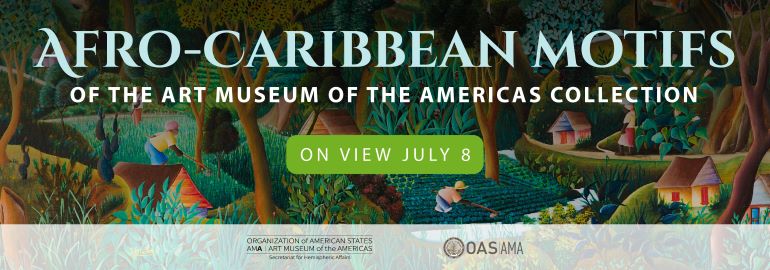
Afro-Caribbean Motifs of the Art Museum of the Americas Collection
On view July 9, 2022 through March 15, 2023
HOURS
Tuesday-Sunday 10AM-5PM
LOCATION
OAS AMA | Art Museum of the Americas
201 18th Street NW
Washington, DC 20006
ADMISSION
Free
Please wear a well-fitting face mask and maintain six feet of distance
from other visitors.
This exhibition presents artworks of Afro-Caribbean artists core to
the collection of the OAS Art Museum of the Americas, augmented by
representations of African influence on the arts and culture of the
hemisphere. From the mid-1940s through the early 1980s, the OAS art
program was directed by Cuban-born art critic José Gómez Sicre, and
numerous works accessioned into the art collection during that time
period were acquired directly from the artists when they held
exhibitions at the OAS Main Building Gallery, and since its founding
in 1976, the present-day Art Museum of the Americas.
As early as 1947, Haitian artists of both studied and informal
backgrounds were exhibiting at the OAS. The 1948 OAS exhibition
Paintings from Haiti demonstrated a wide range of disciplines, and a
series of woodcuts rendered by Haitians Gabriel Alix, Castera Bazile,
Rigaud Benoit, Gabriel Leveque, and Luismond Merelus came into the OAS
collection soon after. Sculptor Georges Liautaud exhibited The
Crucifixion at the OAS in 1960, influenced by the nation’s metal
cutout artists. In the outstanding Haitian Landscape, Joseph
Jean-Gilles depicts idyllic scenes of village life and heavenly
visions through earthly lives. Stan Burnside (Bahamas) incorporates
“elemental and mystical symbolism rooted in his African heritage,“
as seen here in Old Time Religion. Jamaican Brother Everald Brown’s
alignment with the Ethiopian (Coptic) Orthodox Church birthed more
overtly religious subjects, while Kapo was a leader in Jamaica’s
Zion Revival movement, imbuing his Solomon with reverence. Known for
the dignity and racial pride of his subjects, fellow Jamaican Karl
Parboosing’s self-portrait, completed near the end of his life, is
no exception.
In Candido Portinari’s Return from the Fair, an Afro-Brazilian woman
and five daughters revel among a rich evening tapestry. This piece was
gifted to José Gómez Sicre from the artist, and in turn accessioned
into the collection of the Pan American Union, now the AMA, as its
first artwork. Another of the earliest works of the OAS art
collection, Celeste Woss y Gil’s Tobacco Vendor (1938) depicts
Dominican rural life and its working people. Emerging from the Havana
School in the 1940s, Mario Carreño worked with a specifically Cuban
vocabulary. Uruguayans Pedro Figari and Carlos Paez Vilaro painted
scenes of working life bustling with activity and energy, the latter
going on to paint the Roots of Peace mural at the OAS headquarters,
addressing themes of peace, studiousness, sporting, and racial
justice.
In contemporary times, the AMA has collected outstanding photographs
from the likes of Domingo Batista (Dominican Republic), Ronnie
Carrington (Barbados), Owen Minott (Jamaica), and Fausto Ortiz
(Dominican Republic), all of whom offer glimpses into modern
Afro-Caribbean lives. Patricia Kaersenhout (Suriname) examines
feminism, sexuality, racism, and the history of slavery through the
lens of the African Diaspora. Stanley Greaves’ (Guyana) Slave Stock
and Whip (2018) speaks plainly to the enslavement of human beings and
its brutal legacy.
These artworks offer an artistic component of the Organization of
American States (OAS) Plan of Action for the Decade of
Afro-Descendants in the Americas (2016-2025), in recognizing that
people of African descent in the Americas are descendants of millions
of Africans who were forcibly enslaved and transported as part of the
inhumane transatlantic slave trade between the 15th and 19th
centuries. This aims to promote awareness of the histories of people
of African descent in the Americas and to ensure their fuller
participation in social, economic, and political life, and mandates
the annual commemoration of the International Day for the Remembrance
of Victims of Slavery and the Trans-Atlantic Slave Trade, while also
fostering greater awareness and respect for the diversity of the
heritage and culture of people of African descent and their
contribution to the development of society. This richness of cultural
heritage is as intrinsic to the arts of the hemisphere as it is to the
social fabrics of its regions.
Accessibility: This exhibition takes place on AMA’s second floor.
The galleries are not wheelchair accessible. Restrooms are located on
the second floor. There is a flight of winding stairs leading to the
museum's second floor. For more information on accessibility, please
contact 202 370 0147 or artmus@oas.org
![]()
![]()
![]() Home |
Join |
Sign Up |
Donate |
Contact us
Home |
Join |
Sign Up |
Donate |
Contact us

